
Economics_-_New_Ways_of_Thinking
.pdf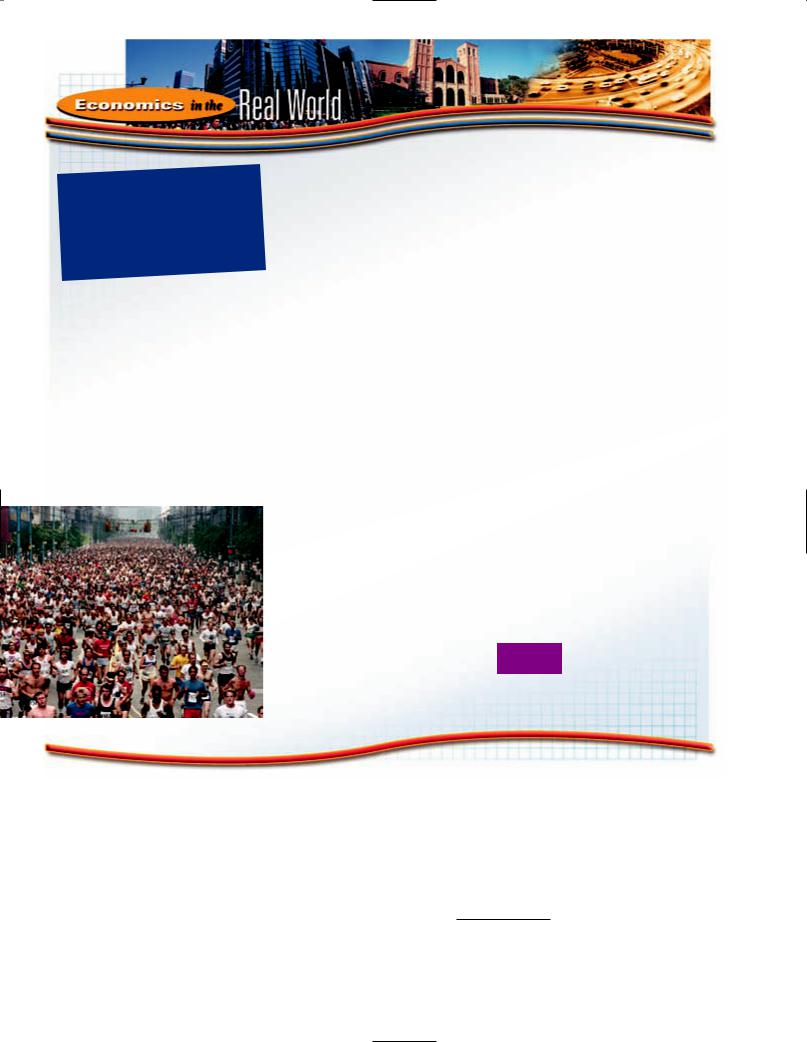
???WhoFeeds Cleveland?
Rarely does anyone ask who feeds Cleveland, or who
feeds the people in any other city in the world for that matter. Most of us take it for granted that we somehow get fed. We go to the grocery store, we select certain items off the shelves, we pay for those items, and then we go home and eat the food. What more do we need to think about?
To understand just how much is involved, suppose you had the job of feeding Cleveland: You need to tell farmers how much corn, wheat, and soybeans to grow. You need to decide what the right price is for Cheerios and ketchup and milk. (How do you figure out these prices?) You need to send so many boxes of orange juice to various grocery stores. (We wonder whether you might send too much orange juice to one grocery store and not enough to another.)
To get the right amount of food to your local grocery store, literally hundreds of decisions have to be made along the way. Yet, no giant computer decides how much corn and wheat will be grown and how much orange juice will be sent to the grocery store at the corner of 13th Street and Main. No government bureaucracy in Washington, D.C., decides such things. As far as we know, we cannot point to a single person in the world and say, “She feeds Cleveland.”
Well, if no one feeds Cleveland, then how does Cleveland get fed? The answer is “supply and demand” feeds Cleveland. That’s right, supply
and demand, or what we have come to know as “the market.” If the demand for Cheerios rises, the price rises, which prompts the manufacturer of Cheerios to produce more Cheerios. If the demand for corn rises, the price rises, which prompts corn farmers to plant and harvest more corn. If the demand for fat-free ice cream falls, then fat-free ice cream stays on the grocery shelves longer, and soon the price drops, which signals to ice cream manufacturers that they shouldn’t produce as much fat-free ice cream.
A famous economist once said that if “supply and demand” or “the market” didn’t naturally exist, it would have to be invented—and then it would be hailed as the greatest invention the world had ever seen. Of course, the market was not invented, it just is.
Who feeds Cleveland, New York, Chicago, New Orleans, London, Buenos Aires, and Paris?
And who feeds you?
If the market had been invented, how would it
compare to inventions such as the wheel and fire?
supply of freeway space (say, four lanes for 150 miles). The demand curve D (11 p.m.) represents the demand for freeway space at 11 p.m. Monday, and the demand curve D (8 a.m.) represents the demand for freeway space at 8 a.m. Monday. You will notice that the demand at 8 a.m. is greater than the demand at 11 p.m.
What do most people have to pay to drive on the freeway? For most freeways across
the country, the price is zero; most freeways do not have tolls.1 In Exhibit 6-7(a), you will notice that zero price is the equilibrium price at 11 p.m. on Monday. The demand curve for freeway space and the supply curve of freeway space intersect at zero price at
1 People do pay taxes to build freeways, but this fact is not relevant here. People are not paying a price to drive on freeways, at least not nontoll freeways.
144 Chapter 6 Price: Supply and Demand Together
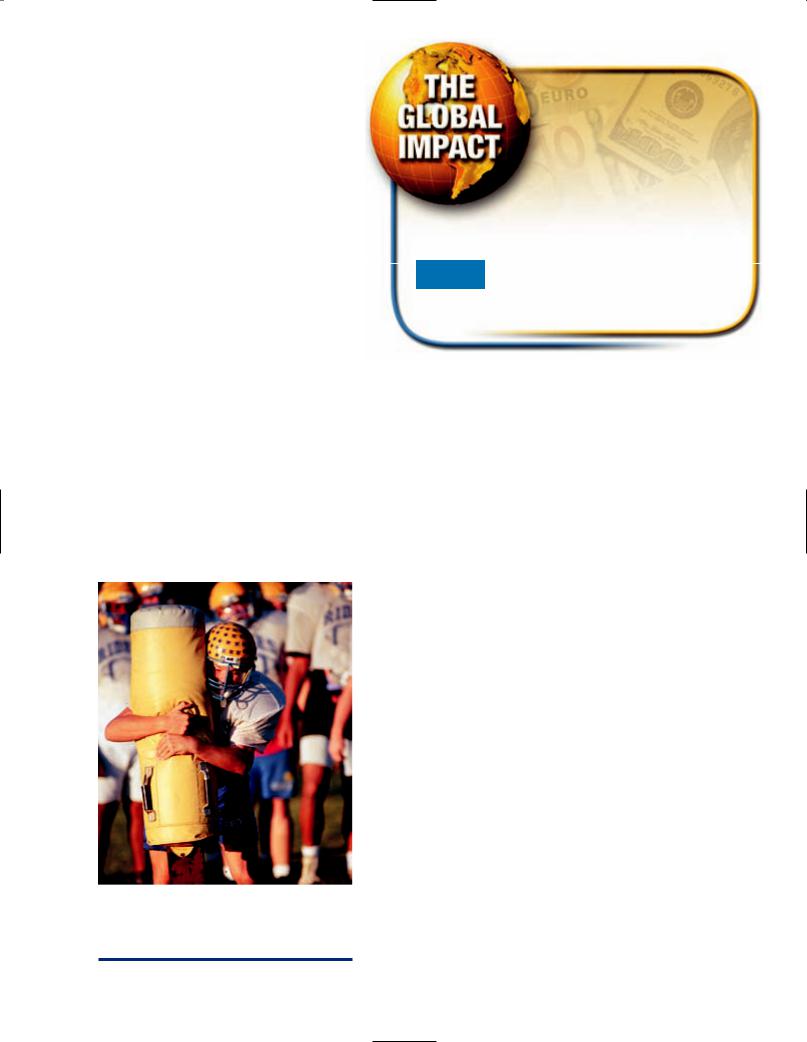
11 p.m. on Monday. In other words, at this time neither a shortage nor a surplus of freeway space exists. People are using the freeway. Traffic is moving freely without congestion.
Now look at the situation at 8 a.m. At zero price—no toll—the quantity demanded of freeway space is greater than the quantity supplied, resulting in a shortage of freeway space. In everyday language, the freeway is congested. If you have ever been in a major traffic jam, you can probably understand that a congested freeway means a shortage of freeway space.
What is the solution to freeway congestion? Two common solutions are building more freeways and having people carpool. One solution deals with the supply side of the freeway market, and the other with the demand side. When people say that we ought to build more freeways, they want to push the supply curve (of freeway space) to the right, shown in Exhibit 6-7(b). If the supply of freeway space shifts from S1 to S2, freeway space is able to meet the quantity demanded at zero price at 8 a.m. The problem of freeway congestion is solved.
If more people carpool, then for all practical purposes the demand for freeway space
What factors determine how hard this player has to work and how skilled he has to be to win a position on the team?
Offshoring
In 2003, the McKinsey Global Institute calculated that offshoring (U.S. companies hiring workers in other countries) came
with both costs and benefits but that overall the benefits were greater
than costs. One benefit, especially noted, was lower costs for U.S. companies.
How might lower costs for U.S. companies affect both the supply of goods in
the United States and the prices customers pay for those goods?
falls as in Exhibit 6-7(c). In other words, if people carpool to such an extent that the demand for driving on the freeway drops by as much as shown in the exhibit, then freeway space is able to meet the quantity demanded at zero price at 8 a.m. The shortage of freeway space again is eliminated.
Of course, as is probably evident now, a third way can be used to get rid of freeway congestion. It has nothing to do with building more freeways or carpooling. Freeway congestion can be eliminated by charging tolls. The tolls bring the freeway market into equilibrium. In other words, as shown in Exhibit 6-7(a), a toll of $1.50 would eliminate freeway congestion at 8 a.m.
Supply and Demand on the Gridiron
Suppose you want to try out for a high school sport, such as football, volleyball, or golf. How competitive do you have to be to get on the team? It depends on how many open positions are available on the team you want to try out for, as well as how many people are going to try out for those positions. How competitive you must be is a matter of the supply of positions and the demand for positions.
Suppose you want to try out for tight end on the high school football team. The team’s coach has decided that he will have three tight ends on the team. In economic terms,
Section 2 Supply and Demand in Everyday Life 145

we can say that the quantity supplied of tight end positions is three. Suppose that 30 people want to try out for the position of tight end. The quantity demanded of tight end positions is then 30. Because quantity demanded is greater than quantity supplied, a shortage of tight end positions results.
When a shortage of anything occurs in a competitive market, the price of that thing rises. The team’s coach, of course, is not going to accept money from the students who want to try out for the team. What he will do is raise the “price” of being a tight end in a different way. People will have to “pay” to be a tight end with hard work and skill. The players who pay more—demon- strate more skill and work harder—will be the ones to make the team as tight ends.
Would these players have to be as good to get on the team if only five people wanted to be a tight end? Not at all. In that case, the shortage of tight end positions would be smaller, and the “price” of being a tight end would not rise as much to bring supply and demand into equilibrium.
Supply and Demand on the College Campus
As you probably know, you do not need the same grade point average (GPA) or standardized test score (SAT or ACT) to get into all colleges. One college may require a GPA of 3.0 and an SAT score of 1550, while another requires a GPA of 3.8 and an SAT score of 2100.2 Why the difference? Again, the answer is supply and demand. The higher the demand to get into a particular college, the higher its entrance requirements.
Take two colleges, college A and college B. Each college will admit 2,000 students to its entering freshman class next year. Each college charges $5,000 a semester in tuition. The quantity supplied of open spots and the tuition are the same at each college, but suppose the demand to go to college A is three times the demand to go to college B. At college B, 4,000 students apply for 2,000 spots, but 12,000 students apply for 2,000 spots at college A.
2 The new SAT scores used here first went into effect in March of 2005.
The shortage at college A is greater than the shortage at college B, so the “price” to get into college A will rise by more than it will rise at college B. The “price” of getting into college is usually measured in terms of high school academic performance (in other words, GPA and SAT or ACT scores.) The greater the demand to get into a college compared to supply, the higher the GPA and standardized test scores required to get into that college, or the higher the “price” a student must pay in terms of grades.
 Suppose a university charges tuition of $12,000 a year and requires a 3.0 GPA and an SAT score of 1900 or higher for admission. Currently, 7,000 students apply for admission each year and 2,000 are admitted. Time passes and the number of applicants rises to 10,000. We know that a rise in the number of applicants is just another way of saying that demand to attend the university increased.
Suppose a university charges tuition of $12,000 a year and requires a 3.0 GPA and an SAT score of 1900 or higher for admission. Currently, 7,000 students apply for admission each year and 2,000 are admitted. Time passes and the number of applicants rises to 10,000. We know that a rise in the number of applicants is just another way of saying that demand to attend the university increased.
Our study of supply and demand teaches us that if demand rises, tuition will rise too. In other words, tuition might rise to $16,000 a year. Suppose the university chooses not to raise tuition; it maintains tuition at $12,000 a year. Will the standards of admission rise instead? The answer is yes—the university might start requiring a 3.3 GPA and an SAT score of 2000 or higher.
Necessary Conditions for a High Income: High Demand, Low Supply
As consumers, we are used to paying prices. We pay a price to buy a computer, a soda, or a shirt. We sometimes receive prices, too. As a seller of a good, you receive the price that the buyer pays.
Many people do not sell goods; instead, they sell their labor services. The person who works at a fast-food restaurant after school or an attorney at a law firm is selling labor services. The “price” employees receive for what they sell is usually called a wage. A wage, over time, can be referred to as a salary or income. A person who earns a wage of $10 an hour receives a monthly income of $1,600 if he or she works 160 hours a month.
146 Chapter 6 Price: Supply and Demand Together
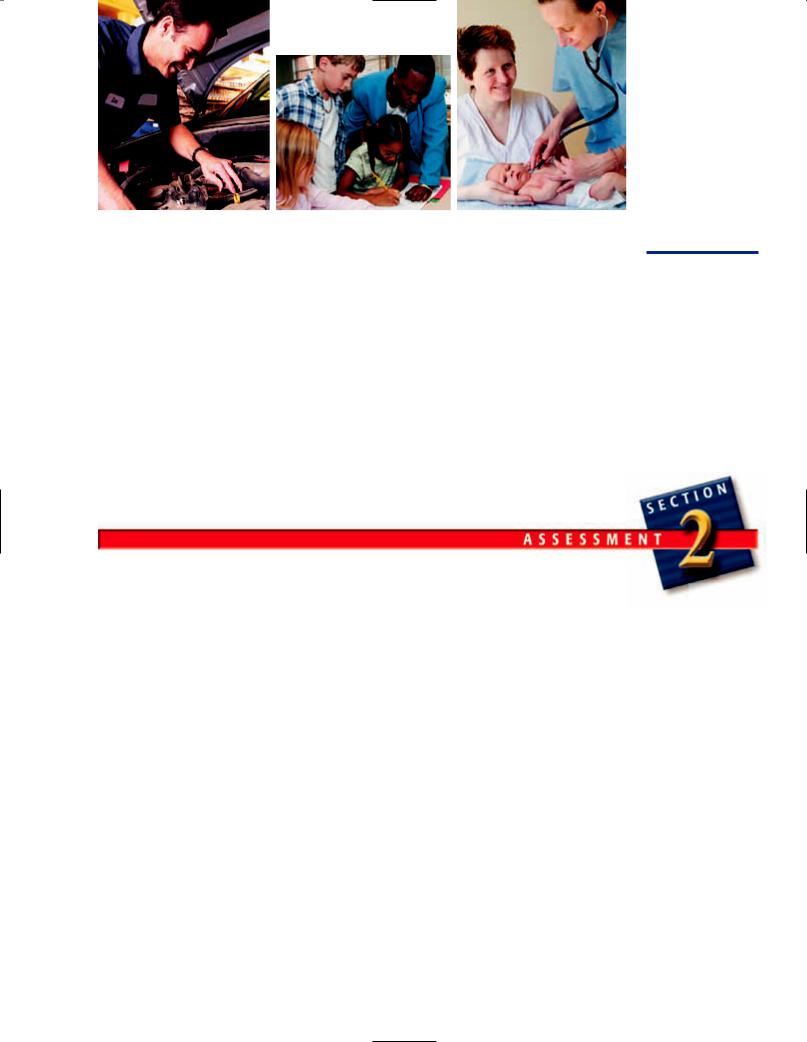
A wage is determined by supply and demand, just as the price of oranges, apples, or TV sets is. It follows, then, that for someone to receive a high wage, demand must be high and supply low. The higher the demand relative to supply, the higher the wage will be.
To earn a high wage, then, is to perform a job in great demand that not many other people can do. If few know how to do it, supply will be low. Low supply combined with high demand means you will receive a (relatively) high wage.
Consider the wage of a restaurant server versus a computer scientist. The demand is
tists. However, a large supply of servers and a not-so-large supply of computer scientists mean that computer scientists earn more than servers.
 In 2005, Randy Johnson was a pitcher for the New York Yankees. His salary that year was $15,419,815. Why was his salary so high? The answer: high demand, low supply. The demand to watch a good pitcher play in a baseball game is high. The number of people in the world who can pitch a baseball the way Randy Johnson pitches is small. High demand and low supply is the
In 2005, Randy Johnson was a pitcher for the New York Yankees. His salary that year was $15,419,815. Why was his salary so high? The answer: high demand, low supply. The demand to watch a good pitcher play in a baseball game is high. The number of people in the world who can pitch a baseball the way Randy Johnson pitches is small. High demand and low supply is the
Whether your future occupation is auto mechanic, teacher, doctor, or anything else, your income will be determined by supply and demand. Can you explain how supply and demand impact wages?
Reviewing Facts and
Concepts
1.A freeway sometimes experiences traffic congestion (bumper-to- bumper traffic) and sometimes very little traffic. Explain why.
2.Housing prices are higher in city X than in city Y. Using the concepts of supply and demand, explain why.
3.Identify whether a shortage, a surplus, or equilibrium exists in the following settings:
a.Fewer students apply for the first-year class at college X than spaces available.
b.People who wanted to attend a baseball
game were told that tickets had sold out the day before.
c.Houses for sale used to stay on the market for two months before they were sold. Now they are staying on the market for up to six months, and they still aren’t selling.
Critical Thinking
4.Carmelo says, “A movie theater charges the same price for a popular movie as it does for an unpopular movie. Obviously, the movie theater doesn’t charge more when demand for the movie is higher than when it is lower.” Shelby counters
by saying, “Movie theaters often call the more popular movies special engagements and do not accept any discount tickets for them.” If Shelby is correct, does her point negate Carmelo’s? Explain your answer.
Applying Economic
Concepts
5.This section stated that people will earn high incomes if they can supply labor services that not many other people can supply, and for which demand is great. If you choose to go to college, how will this information affect your supply position?
Section 2 Supply and Demand in Everyday Life 147

The WWW Gets You More for Less
Information is something people will pay to have. We see it a hun-
dred times a day. A person who wants to sell her house will pay a real estate agent to inform her of where the buyers are who want to buy her house. A person who wants to buy bonds and stocks might pay a financial analyst to inform him of the best stocks and bonds to buy. Just as people buy goods and services every day, they also buy information every day.
The World Wide Web
The introduction of the World Wide Web has made it cheaper and easier to acquire certain information. You just need to know where to look.
Buying a Car Let’s suppose that Jimmy wants to buy a Honda Accord. The list price of the car is $23,100. But Jimmy wants to know the invoice price; he wants to know what the dealer paid for the car. He can go to www.emcp.net/autobytel and find that the invoice price is $20,788. Knowing the invoice price gives Jimmy information that he didn’t have before. It is information that is useful to him when he is negotiating the price he will pay for the car.
Suppose Jimmy just wants to know what cars are especially safe for teenagers. He can go to
www.emcp.net/consumerreports and click on “cars for teen drivers.” He will then find a list of recommended cars that have advanced safety features and good crash-test results.
Comparing Prices Suppose Katherine wants to buy a television set. Instead of going from store to store to price sets, she can go to www.emcp.net/consumerworld. There she can click on the “Price Checker” for TV sets and in two seconds, she can see a list of 12 or more stores (in her area) that are willing to sell her the TV she is looking at, each listing its price for the TV set.
Suppose Ivan wants to find where he can get gas for as little
as possible. He can go to www.emcp
.net/firstgov and click on “Find Cheapest Gas Prices.” On his next screen he will see a map of the
United States. He clicks on his state, New York, and then on his city, Buffalo. Up pops a list of gasoline stations with gas prices per gallon listed.
Background Checks Suppose Melissa is thinking about having a medical operation. She wants to know something about the surgeon who is planning to do the operation. What’s his education? Is he a good surgeon? Is he board certified? Have there been any disciplinary actions taken against him? All she needs
to do is go to www.emcp.net/ healthgrades and click on “Physician Quality Reports.” There she can purchase (for about $8) a full report on her surgeon.
College Information Suppose it is Oliver’s first year at college and he wants to know what students at his
If you want to get the best deal possible, you have to do some research.
148 Chapter 6 Price: Supply and Demand Together

With so much valuable information available on the Web, there are no excuses for making poor buying decisions.
has some of the highest gas prices in the county.
Many companies will advertise that you can get a “free” credit report from them. An ad might read: “Want to know what your credit report says. Come to our Web site and you’ll get a free credit report in minutes.”
Fact is, many of the companies that advertise “free” credit reports don’t deliver free credit reports. Often once at their sites they will try to get you to sign up for subscription-based services sold by credit bureaus. As of this writing, only one congressionally mandated site, AnnualCreditReport
.com, provides a free credit report. Oddly enough, though, if you do a search of “free credit report” on the search engine Google, AnnualCredit Report.com doesn’t even make the first page of Google results.
college think about some of the professors whose courses he wants to take. He can go to www.emcp.net/ ratemyprofessors and find out. Once at the site, all he has to do is choose the state, the college, and then the professor. Here’s what we found written about one professor: “All we did was watch videos. What a hack.” And here’s what we found written about another: “Best class I’ve ever had. Her lectures are clear and she is always there to help you.”
Caveat Emptor
When it comes to buying goods and services, it is sometimes good to remember the saying “caveat emptor,” which means “let the buyer beware.” It means that you, as a buyer, have the responsibility of watching out for yourself. Sellers will not always tell you everything they think you want to know. A car salesperson isn’t likely to tell you how poorly the car you’re looking at did in the national crash tests. The surgeon isn’t likely to tell you that he has two disciplinary actions pending. The gas station isn’t likely to advertise that it
|
|
|
|
|
|
|
|
|
|
|
|
|
Economics |
Action |
Plan |
|
||||||||||||||||||||||||||||
My Personal |
|
|
|
|
|
|
|
|||||||||||||||||||||||||||||||||||||
|
|
|
|
|
|
|
|
|
and some |
|
||||||||||||||||||||||||||||||||||
|
|
|
you may want |
to consider |
|
|
||||||||||||||||||||||||||||||||||||||
|
|
|
|
|
|
|
|
|
|
|
|
|
|
|
|
|
|
|||||||||||||||||||||||||||
|
|
|
|
are some |
points |
|
|
|
|
|
|
|
|
|
||||||||||||||||||||||||||||||
Here |
|
|
|
|
|
. |
|
|
|
|
|
|
|
|
|
|
|
|
||||||||||||||||||||||||||
|
|
|
|
|
|
|
|
|
|
|
|
|
|
|
|
|
|
|
|
|
|
|
|
|
|
|
|
|||||||||||||||||
|
you might |
want |
|
to put into |
practice |
|
|
|
|
|
|
|
|
|
for |
|||||||||||||||||||||||||||||
guidelines |
|
|
|
|
|
|
|
|
and less costly |
|||||||||||||||||||||||||||||||||||
|
|
|
|
|
|
|
|
|
|
|
|
|
|
|
||||||||||||||||||||||||||||||
|
|
|
|
|
|
|
|
|
|
it easier |
||||||||||||||||||||||||||||||||||
|
|
|
|
|
|
Wide Web makes |
|
|
|
|||||||||||||||||||||||||||||||||||
1. |
|
|
The World |
. Use the |
Web to |
|||||||||||||||||||||||||||||||||||||||
|
|
|
|
|
|
|
|
|
|
|
||||||||||||||||||||||||||||||||||
|
|
|
|
|
|
|
|
|
|
|
|
|
|
|
|
|
|
|
|
|
|
consumer |
|
|
|
|
|
|
|
|
|
|
|
|
||||||||||
|
|
|
|
|
|
|
|
|
|
|
|
|
|
|
an |
informed |
|
|
|
|
|
|
|
|
|
|
|
- |
||||||||||||||||
|
|
|
|
you to become |
|
|
|
|
|
|
|
and services |
you are |
think |
||||||||||||||||||||||||||||||
|
|
|
|
learn |
about |
the products |
|
|
|
|
|
|
|
|
|
|
|
|||||||||||||||||||||||||||
|
|
|
|
|
|
|
|
|
|
|
|
|
|
|
|
|
|
|
|
|
|
|
|
|
|
|
||||||||||||||||||
|
|
|
|
|
|
|
|
. |
|
|
|
|
|
|
|
|
|
|
|
|
|
|
|
|
|
|
|
|
|
|
|
|
|
|
||||||||||
|
|
|
|
|
|
|
|
|
|
|
|
|
|
|
|
|
|
|
|
|
|
|
|
|
|
|
|
|
|
|
|
|
|
|
|
|
|
|
||||||
|
|
|
|
|
|
|
|
|
|
|
|
|
|
|
|
|
|
|
|
|
|
|
|
|
|
|
|
|
|
|
|
|
|
|
|
|
|
|
|
|
|
|
||
|
|
|
|
ing about |
buying |
|
|
|
|
|
|
|
|
|
|
|
______ |
within |
the |
|
|
|||||||||||||||||||||||
|
|
|
|
|
|
|
|
|
|
|
|
|
to determine |
|
|
|||||||||||||||||||||||||||||
|
|
|
|
|
|
|
|
|
|
|
|
|
|
|
|
|
|
|
|
|
|
|||||||||||||||||||||||
|
|
|
|
|
|
|
|
|
|
|
|
______ |
|
|
|
|
||||||||||||||||||||||||||||
|
I will research |
|
|
|
|
|
|
|
|
|
|
|||||||||||||||||||||||||||||||||
|
|
|
|
|
|
|
|
|
|
|
|
|
|
|
|
|
||||||||||||||||||||||||||||
|
|
|
|
|
|
|
|
|
|
|
|
|
|
|
|
|
|
|
|
|
|
|
|
|
|
|||||||||||||||||||
|
|
. |
|
|
|
|
|
|
|
|
|
|
|
|
|
|
|
|
|
|
|
|
|
|
|
|
|
|
|
|
|
|
|
|||||||||||
|
|
|
|
|
|
|
|
|
|
|
|
|
|
|
|
|
|
|
|
|
|
|
|
|
|
|
|
|
|
|
|
|
|
|
|
|
|
|
|
|
|
|
|
|
|
next |
six months |
|
|
|
|
|
|
|
|
|
|
|
|
|
|
|
|
|
|
|
|
|
|
you with the |
|||||||||||||||||||
|
|
|
|
|
|
|
|
|
|
|
|
|
|
|
|
|
|
|
|
|
|
|
|
|
|
|
|
|
|
|
|
|||||||||||||
|
|
|
|
|
|
|
|
|
|
|
|
|
|
|
|
|
always willingly |
provide |
||||||||||||||||||||||||||
|
|
|
|
|
|
|
|
|
will not |
|
|
|
|
|
|
|
- |
|
||||||||||||||||||||||||||
|
|
|
|
|
|
|
|
|
|
|
|
|
|
|
|
|
|
|
|
|
|
|
||||||||||||||||||||||
|
|
2. |
|
Sellers |
|
|
|
|
|
|
|
|
|
before |
you make |
a pur |
|
|||||||||||||||||||||||||||
|
|
|
|
|
|
|
|
|
|
|
|
|
|
|
|
|
|
|
|
|
|
|
|
|
|
|||||||||||||||||||
|
|
|
information |
you may want |
|
|
|
|
|
|
. Remember: |
|||||||||||||||||||||||||||||||||
|
|
|
|
|
|
|
|
|
|
|
|
|
|
|
|
|
||||||||||||||||||||||||||||
|
|
|
|
|
|
|
|
|
to watch |
out for yourself |
|
|
|
|
|
|
||||||||||||||||||||||||||||
|
|
|
|
|
|
|
|
.You have |
|
|
|
|
|
|
||||||||||||||||||||||||||||||
|
|
|
|
|
|
|
|
|
|
|
|
|
|
|
|
|
|
. |
|
|
|
|
|
|
|
|
|
|
||||||||||||||||
|
|
|
|
|
chase |
|
|
|
|
|
|
|
|
|
|
|
|
|
|
|
|
|
|
|
|
|
|
|
|
|
|
|
|
|
|
|
|
|
|
|
||||
|
|
|
|
|
|
|
|
|
|
|
|
|
|
|
|
—let the buyer |
beware |
|
|
|
|
|
|
|
|
|
|
|||||||||||||||||
|
|
|
|
|
caveat |
emptor |
|
|
|
|
|
|
|
|
|
|
|
|
|
|
|
|
I will ______ |
to |
||||||||||||||||||||
|
|
|
|
|
|
|
|
|
|
|
|
|
|
|
|
major |
purchase, |
|||||||||||||||||||||||||||
|
|
|
|
|
|
|
I make |
my |
next |
|
|
|
|
|
|
|
|
|
. |
|
||||||||||||||||||||||||
|
|
|
|
|
|
|
|
|
|
|
|
|
|
|
|
|
|
|
|
|
|
|
|
|
|
|||||||||||||||||||
|
|
|
|
|
|
|
|
|
|
|
|
|
|
|
|
|
|
|
|
|
|
|
|
|
|
|
|
|
||||||||||||||||
|
|
|
Before |
|
I am making |
a smart |
buying |
decision |
|
|
||||||||||||||||||||||||||||||||||
|
|
|
make |
sure that |
|
|
|
|
|
|
|
|
|
|
|
|
|
|
||||||||||||||||||||||||||
|
|
|
|
|
|
|
|
|
|
|
|
|
|
|
|
|
|
|
|
|
|
|
|
|
||||||||||||||||||||
|
|
|
|
|
|
|
|
|
|
|
|
|
|
|
|
|
|
|
|
|
|
|
|
|
|
|
|
|
|
|
|
|
|
|||||||||||
|
|
|
|
|
|
|
|
|
|
|
|
|
|
|
|
|
|
|
|
|
|
|
|
|
|
|
|
|
|
|
|
|
|
|
|
|
|
|
|
|
|
|||
Chapter 6 Price: Supply and Demand Together 149
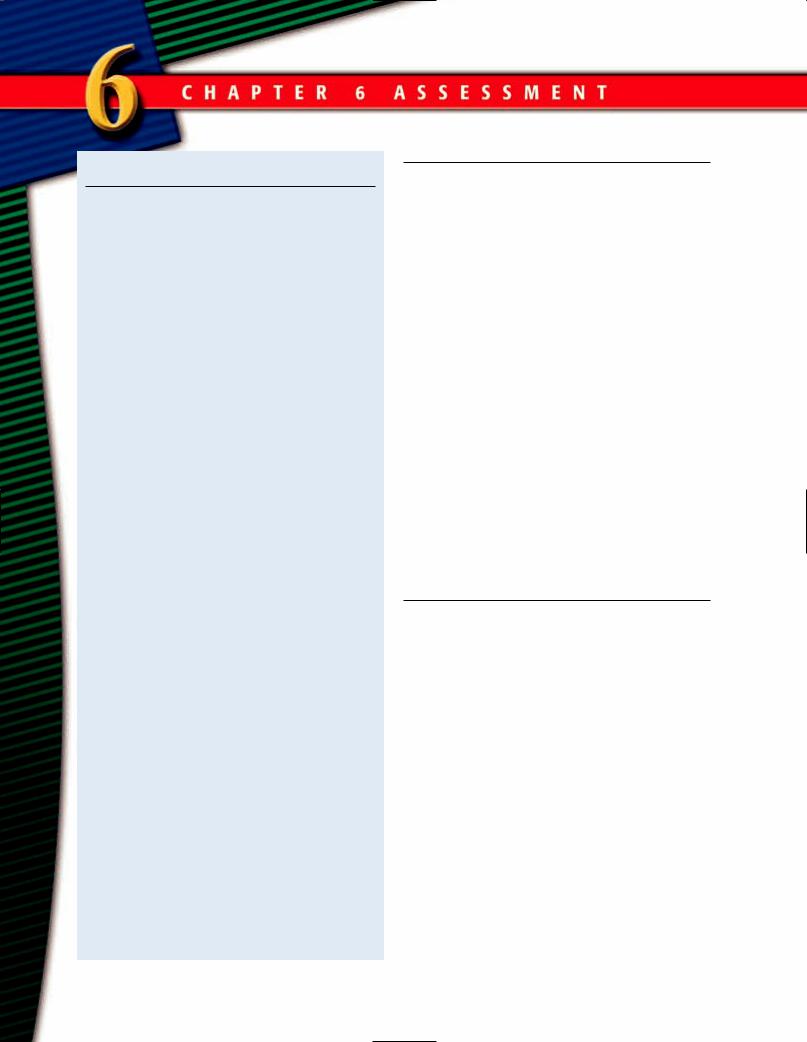
Chapter Summary
Be sure you know and remember the following key points from the chapter sections.
Section 1
Supply and demand work together to determine price.
A surplus exists when quantity supplied is greater than quantity demanded.
A shortage exists when quantity demanded is greater than quantity supplied.
A market reaches equilibrium when the quantity of a good that buyers are willing and able to buy is equal to the quantity of the good that sellers are willing and able to produce and offer for sale, and is shown as the intersection point of the supply and demand curves.
The cost of storing inventories is part of the reason prices decrease when a surplus occurs.
A shift in the demand curve will cause prices to increase or decrease.
A shift in the supply curve will also cause a change in price.
Governments sometimes legislate price controls: a price ceiling sets a level that a price for a good cannot go above legally, and a price floor is the lowest price at which a good can be sold legally.
Section 2
A shortage in a market causes price to increase.
A surplus in a market causes price to decrease.
The laws of supply and demand affect many areas of our lives: the price of goods and services, the likelihood of getting into a certain university or on a certain sports team, how much traffic is on the roads, and how much money we earn in our jobs.
All other factors being the same, prices and quantity will always move toward the equilibrium point.
Economics Vocabulary
To reinforce your knowledge of the key terms in this chapter, fill in the following blanks on a separate piece of paper with the appropriate word or phrase.
1.A(n) ______ exists when quantity supplied is greater than quantity demanded.
2.A(n) ______ exists when quantity demanded is greater than quantity supplied.
3.A market is in ______ when quantity demanded equals quantity supplied.
4.The price that exists in a market when quantity demanded equals quantity supplied is called the
______.
5.The quantity that exists in a market when quantity demanded equals quantity supplied is called the ______.
6.In a market, if quantity supplied is currently greater than quantity demanded, a firm’s ______
is/are above normal levels.
7.A(n) ______ is a legislated price below which legal trades cannot be made.
8.A(n) ______ is a legislated price above which legal trades cannot be made.
Understanding the Main Ideas
Write answers to the following questions to review the main ideas in this chapter.
1.Explain why price falls when a surplus occurs.
2.Look at the prices listed in Exhibit 6-1. At what prices does a surplus occur? What are the equilibrium price and the equilibrium quantity?
3.“All markets are necessarily in equilibrium at all points in time.” Agree or disagree? Explain.
4.What might we see when a market is experiencing a shortage? (Comment: It is not enough to say that quantity demanded is greater than quantity supplied because this answer is simply a definition of shortage. You must identify a tangible event of a shortage.)
5.Pens sell for about the same price in every city in the country, but houses do not. Why?
6.Alfred Marshall, the British economist, compared supply and demand to the two blades of a pair of scissors. Explain his thinking.
150 Chapter 6 Price: Supply and Demand Together
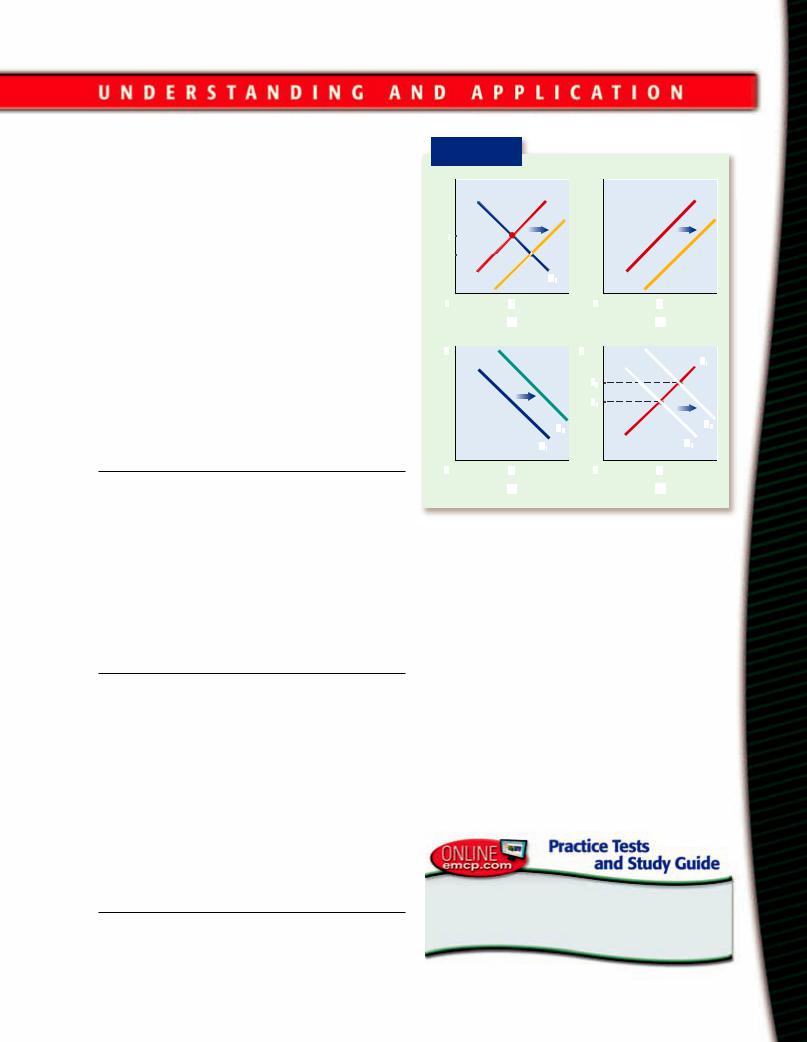
7.Identify what will happen to equilibrium price and equilibrium quantity in each of the following cases:
a.Demand rises and supply is constant.
b.Demand falls by more than supply rises.
c.Supply rises by more than demand rises.
d.Supply falls and demand is constant.
8.Suppose you are a manager of a grocery store. How would you know which goods were in shortage? In surplus?
9.Both the demand for and the supply of a good rise. Under what condition will the price of the good remain constant?
10.Some National Basketball Association (NBA) players receive annual incomes of several million dollars. Explain their high salaries in terms of supply and demand.
Doing the Math
Do the calculations necessary to solve the following problem.
1.Price is $10, quantity demanded is 100 units, and quantity supplied is 130 units. For each dollar decline in price, quantity demanded rises by 5 units, and quantity supplied falls by 5 units. What is the equilibrium price?
Working with Graphs and Tables
1.Identify the exhibit in the chapter that illustrates the following:
a.an increase in demand, supply constant
b.a decrease in supply, demand constant
2.Graphically represent the following:
a.a decrease in demand, supply constant
b.an increase in supply, demand constant
c. a decrease in demand equal to a decrease in supply
3.Explain what is happening in each part, (a)–(d), of Exhibit 6-8.
Solving Economic Problems
Use your thinking skills and the information you learned in this chapter to find solutions to the following problems.
E X H I B I T 6-8
P |
P |
S |
S |
S2 |
S2 |
P 
P2 


|
|
|
|
|
|
|
|
|
|
|
|
|
D |
|
|
|
|
|
|
|
|
|
|
|
|
|
|
|
|
|
|
|
||
|
|
|
|
|
|
|
|
|
|
|
|
|
|
|
|
|
|
|
|
|
|
|
|
|
|
|
|
|
|
|
|
|||
|
|
|
|
|
|
|
Q |
Q |
||||||||||||||||||||||||||
0 |
0 |
|||||||||||||||||||||||||||||||||
|
|
|
|
|
|
|
|
|
|
|
|
|
|
|
|
|
|
|
|
|
|
|
|
|
|
|
|
|
|
|
|
|||
|
|
|
|
|
|
|
(a) |
|
|
|
|
|
|
|
|
|
|
|
|
|
|
|
|
(b) |
||||||||||
|
|
|
|
|
|
|
|
|
|
|
|
|
|
|
|
|
|
|
|
|
|
|
|
|
|
|
|
|
|
|||||
P |
|
|
|
|
|
|
|
|
|
|
|
|
P |
|
|
|
|
|
|
|
|
|
||||||||||||
|
|
|
|
|
|
|
|
|
|
|
|
|
|
|
|
|
|
|
|
|
|
|
|
|
|
|
|
|
|
|
|
|
|
|
|
|
|
|
|
|
|
|
|
|
|
|
|
|
|
|
|
|
|
|
|
|
|
|
|
|
|
|
|
|
|
|
|
||
|
|
|
|
|
|
|
|
|
|
|
|
|
|
|
|
|
|
|
|
|
|
|
|
|
|
|
|
|
|
|
|
|
|
|
|
|
|
|
|
|
|
|
|
|
|
|
|
|
|
|
|
|
|
|
|
|
|
|
|
|
|
|
|
|
|
|
|
||
|
|
|
|
|
|
|
|
|
|
|
|
|
|
|
|
|
|
|
P |
|
|
|
|
|
|
|
|
|
||||||
|
|
|
|
|
|
|
|
|
|
|
|
|
|
|
|
|
|
|
|
2 |
|
|
|
|
|
|
|
|
|
|
||||
|
|
|
|
|
|
|
|
|
|
|
|
|
|
|
|
|
|
|
|
|
|
|
|
|
|
|
|
|
|
|
|
|||
|
|
|
|
|
|
|
|
|
|
|
|
|
|
|
|
|
|
|
P |
|
|
|
|
|
|
|
|
|
||||||
|
|
|
|
|
|
|
|
|
|
|
|
|
|
|
|
|
|
|
|
|
|
|
|
|
|
|
|
|
|
|
|
|
|
|
|
|
|
|
|
|
|
|
|
|
|
|
|
|
|
|
|
|
|
|
|
|
|
|
|
|
|
|
|
|
|
|
|
|
|
|
|
|
|
|
|
|
|
|
|
|
|
|
|
|
|
|
|
|
|
|
|
|
|
|
|
|
|
|
|
|
|
|
D |
|
|
|
|
|
|
|
|
|
|
|
|
|
|
|
D |
|
|
|
|
|
|
|
|
|
|
|
|
|
|
|
|
|
2 |
||
|
|
|
|
|
|
|
|
|
|
|
|
|
|
2 |
|
|
|
|
|
|
|
|
|
|
|
|
|
|
|
|
|
|||
|
|
|
|
|
|
|
|
|
|
|
|
|
|
|
|
|
|
|
|
|
|
|
|
|||||||||||
|
|
|
|
|
|
|
|
|
|
|
|
|
|
|
|
|
|
|
|
|
|
|
|
|||||||||||
|
|
|
|
|
|
|
|
|
|
|
|
|
|
|
|
|
|
|
|
|
|
|
|
|
|
|
|
|
|
|
|
|
|
|
|
|
|
|
|
|
|
|
|
|
|
|
|
|
|
|
|
|
|
|
|
|
|
|
|
|
|
|
|
|
D |
||||
|
|
|
|
|
|
|
|
|
|
D |
|
|
|
|
|
|
|
|
|
|
|
|
|
|
|
|
|
|
|
|
|
|
||
|
|
|
|
|
|
|
|
|
|
|
|
|
|
|
|
|
|
|
|
|
|
|
|
|
|
|
|
|
|
|
|
|
|
|
|
|
Q |
|
Q |
||||||||||||||||||||||||||||||
0 |
|
|
|
|
|
|
0 |
|
|
|
|
|
|
|
|
|||||||||||||||||||
|
|
|
|
|
|
|
|
|
|
|
|
|
|
|
|
|
|
|
|
|
|
|
|
|
|
|
||||||||
|
|
|
|
|
|
|
(c) |
|
|
|
|
|
|
|
|
|
|
|
|
|
|
|
|
(d) |
||||||||||
1.Analysis. Suppose that in 2005 the average price of a meal at a restaurant was $20, and 50,000 restaurant meals were bought and sold. In 2006 the average price was $22, and 60,000 meals were bought and sold. Which of the following events can explain a higher price and more meals purchased and sold? Explain.
a.The supply of restaurant meals increased.
b.The demand for restaurant meals decreased.
c.The demand for restaurant meals increased.
2.Cause and Effect. Suppose the equilibrium price of bread is $2 a loaf. The federal government mandates that no bread can be sold for more than $1 a loaf. How will the market for bread be different from when bread could be purchased and sold for $2? Explain.
Go to www.emcp.net/economics and choose Economics: New Ways of Thinking, Chapter 6, if you need more help in preparing for the chapter test.
Chapter 6 Price: Supply and Demand Together 151
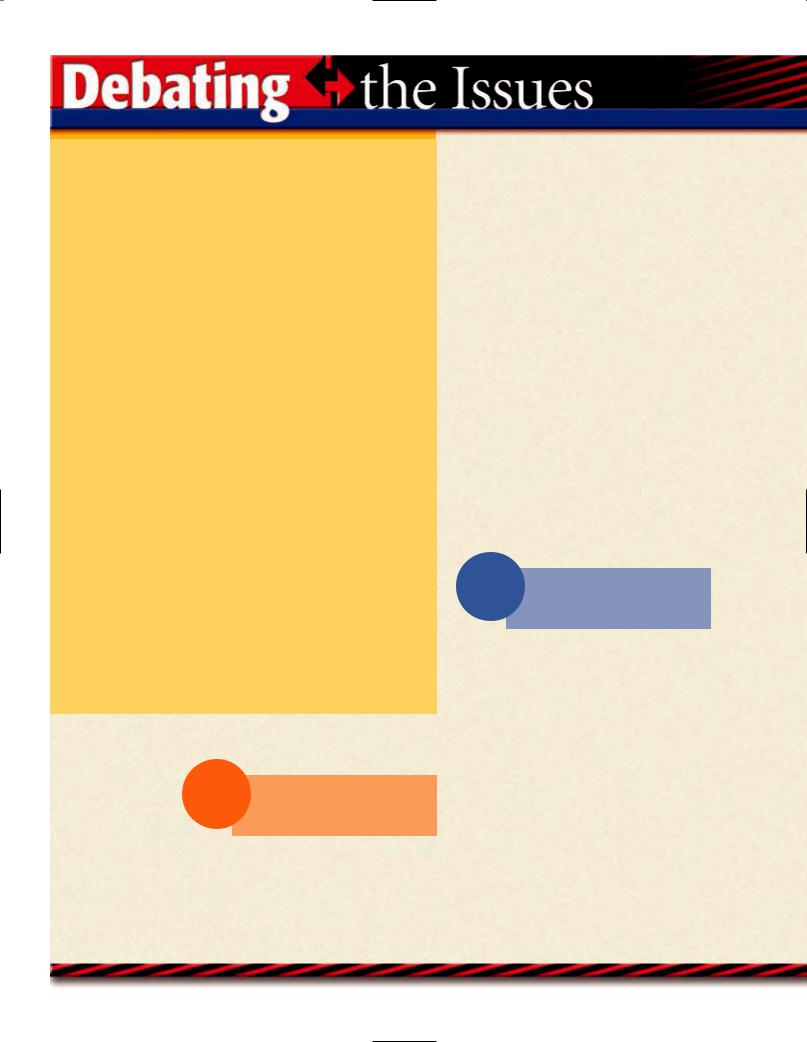
Should There Be Price Controls on Some Goods at Certain Times?
In the summer of 2005, gasoline prices were rising. It was common for people around the country to pay $3 or more per gallon for gasoline.
Then, in the early morning of August 29, 2005, Hurricane Katrina hit the United States and devastated much of the area of the Gulf Coast from New Orleans, Louisiana, to Mobile, Alabama. As a result of Hurricane Katrina, there were breaches in the levee system on the New Orleans side of Lake Pontchartrain, which led to massive flooding and an evacuation of New Orleans.
Just weeks later, Hurricane Rita hit the Gulf Coast area near Galveston, Texas. Hurricane Rita was not as devastating as Katrina, but many of the oil refineries along the coast were put out of commission by the hurricane, further reducing the supply of fuels such as gasoline.
People demanded that something be done. It became common to hear people arguing for price ceilings on gas, on certain food items, and on water. In response, some people argued against price ceilings. Here is what a few people had to say as they discussed the day’s news events at their local coffee shop one morning.
Gilberto Vasquez, marketing manager of a fast-food chain
Gasoline prices have risen nearly 70 cents in just the last week. This is get-
ting ridiculous. It used to be that I paid about $25 to fill up and now I’m paying almost $10 more. For many people, this
spike in gas prices is adding $100 to $200 a month to the amount of money they have to spend. That is a lot of money. What am I supposed to do? After all I have to do a lot of driving in my job. What do I do, buy less food for my family? My daughter needs braces badly. Does she go without braces? I think the federal government should impose a price ceiling for gas. Maybe the ceiling should be set at 20 cents or 30 cents more than the price used to be, so the oil companies can make some money. But there is no need to let the oil companies gouge us by tacking on 70 cents or $1 more in just one week’s time. Did you see the article in the paper this week about one of the oil company’s record profits? Don’t get me wrong. I don’t usually favor government controls. But sometimes I think they are necessary. Why should some people have so much when they are just taking from others?
Winifred Smith,
Economics teacher at
Jefferson High School
I’m not sure I agree with Gilberto’s assumption. He seems to assume that
the oil companies can raise the price of gas to anything they want. But if they could do that, why weren’t they charging more when the price of gas at the pump was under $2 a gallon? They didn’t, I expect, because they couldn’t. Supply and demand determine gasoline prices—not the big oil companies. Supply and demand are impersonal forces, they don’t have an office anywhere in some building. But people always seem to want to blame someone for their predicament. It is just so easy to blame the oil companies.
Well, suppose, the federal government does slam a price ceiling on gas when it is
152 Unit II The Basics
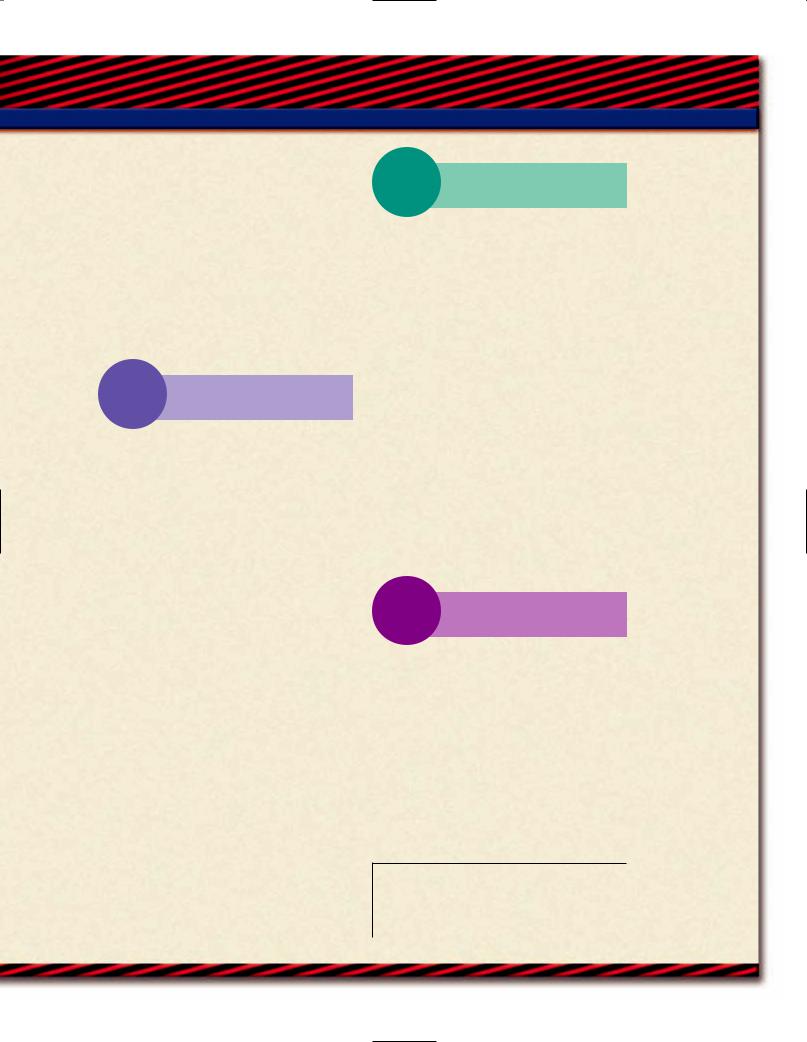
rising rapidly. If that price ceiling is below the equilibrium price, then simple economics tells us that we are going to have some problems. At a price below equilibrium price, shortages will arise. And with shortages, long lines. I can remember back to the late 1970s when the federal government did place a price ceiling on gas at the pump. Sometimes I had to wait for an hour in line to get gas. I don’t want to go back to that.
Patrick Chu, graduate student in physics
Maybe sometimes a long line is better than a high price. Take what happened
after Hurricane Katrina or after any natural disaster. All of a sudden, the price of water rises. What the day before cost $2 to buy, now costs $5 or more to buy.
After Katrina hit, many people had to leave their homes. Some went to Houston, Baton Rouge, Atlanta, and other cities. In many of the cities near where cities were devastated, hotel and motel rooms went for higher daily rates. Some of these motel and hotel owners must have said to themselves, “Well, here come all the people leaving New Orleans, so our motel rooms are going to be in high demand, so now is the time to raise the daily rate.” It seems to me that these people who raise prices dramatically after a natural disaster are profiting on human misery. They see someone in trouble, they see someone who has no choice but to pay the prices they charge, and they sock it to them.
Maybe there should be a law that after natural disaster, no one can raise the price of anything for at least a month. I think I would be in favor of such a law. We shouldn’t allow some people to benefit because other people are in a miserable situation.
Doug Canterfield, salesman
Patrick talks as if price is only there to take money away from some and give to others. Price is a rationing device; that
is what all economists teach you. If the demand for water or motel rooms or gasoline is high, and there is only so much supply, then something is going to have to ration these goods. What should the motel owner do? Ration by brute force: if you are stronger than someone else, you get the motel room? By appearance: the prettier you are the more likely you will get a room?
Patrick seems to forget that price has a job to do and if we don’t let it do its job— which is rationing—something else is going to have to do the job. Patrick didn’t suggest what should become the rationing device for water, or gas, or motel rooms. He simply points a finger at sellers and scolds them.
Anabelle Roberts, high school student
Ithink some good points have been made on both sides of the issue. I guess I would
argue that if people can help one another during a natural disaster, they should. If that means holding prices down, they ought to. After all, presumably the motel owners made money on the day before Hurricane Katrina hit by charging a certain daily rate. Why can’t they make money after the hurricane if they charge the same rate?
What Do You Think?
1.Who do you most nearly agree with? Why?
2.What are the strong points of the debate here? The weak points?
Unit II The Basics 153
